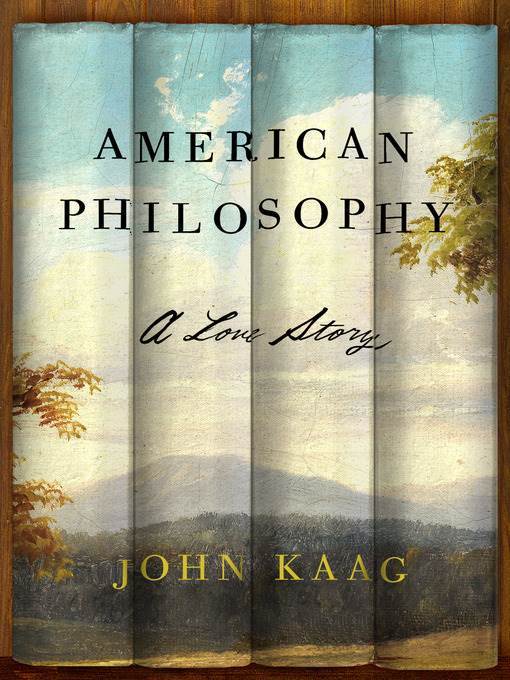
American Philosophy
A Love Story
کتاب های مرتبط
- اطلاعات
- نقد و بررسی
- دیدگاه کاربران
نقد و بررسی

July 25, 2016
Kaag (Thinking Through the Imagination), a professor of philosophy at the University of Massachusetts, Lowell, embarks on a deeply personal search for the answer to the William James–inspired question, “Is life worth living?” Stocking a Subaru with a “case of mediocre pinot noir,” Kaag leaves a stale marriage and drives to the New Hampshire estate of a deceased scholar whose personal library is the equivalent of a philosopher’s candy store. Many of the books are first editions and their margins contain an entire subplot of America’s intellectual history. Kaag bonds deeply with the priceless books while battling his own angst, termites, rodents, and New England weather. Deciding to catalogue the most valuable volumes and place them in temporary storage, he summons help from a colleague. While they pour over Kant and Hegel, romance blooms. Kaag is a scholar at heart and a pack rat for intellectual trivia. Because of this, he risks leaving the reader both emotionally shortchanged and overeducated. There are wondrously frank moments in his narrative, as when he struggles to change a tire and, later, attempts to mow the estate field with a scythe. If only Kaag had sweated more and abstracted less, this would be a perfect book.

Starred review from June 1, 2016
A compelling hybrid combining memoir, a dramatic narrative about saving an endangered rare book collection, and the intellectual history of philosophy. Previously the author of academic tomes (Thinking Through the Imagination: Aesthetics in Human Cognition, 2014, etc.), Kaag (Philosophy/Univ. of Massachusetts, Lowell) recognized a path to writing about philosophy for a general audience by building the story around his unexpected discovery of perhaps 10,000 books in a neglected building on the rural New Hampshire estate of William Ernest Hocking, a deceased Harvard University philosophy professor, and his wife. The first time Kaag entered the estate guided by an acquaintance, he viewed the cohesive collection of rare books in an unsecured building via trespassing. Later, Kaag received permission from the Hocking daughters, who had never cataloged the rare book collection painstakingly built by their parents. The author's discovery came at a juncture of severe personal depression as a postdoctoral scholar at Harvard. His problematic father had died, his youthful marriage was unraveling, and he was obsessed with the question "Is life worth living?" presented most vividly by William James, "the father of American psychology and philosophy." By throwing himself into the salvation of the invaluable Hocking collection, Kaag found an affirmative answer to the question, grappled with the death of his sometimes-hated father, filed for divorce, and, as a touching bonus, fell in love with a female academic colleague who had also divorced. That colleague, Carol Hay, joined Kaag on the New Hampshire estate to help save the rare books. Kaag and Hay married in 2011 and later became parents. Some of the books sold at auctions, and others were donated to libraries and archives with climate controls to aid preservation. Throughout the book, the author deftly intertwines the narrative threads in a story perfect for book lovers and soul searchers alike. Kaag's lively prose, acute self-examination, unfolding romance, and instructive history of philosophy as a discipline make for a surprisingly absorbing book.
COPYRIGHT(2016) Kirkus Reviews, ALL RIGHTS RESERVED.

September 15, 2016
Kaag (philosophy, Univ. of Mass., Lowell; Thinking Through the Imagination) has written a book that is part memoir and part historical analysis of early American philosophy. The work is organized into three sections: Hell, Purgatory, and Redemption. These headings reflect the mood of Kaag's life during the time that he discovered the library of the American philosopher William Ernest Hocking (1873-1966). Through telling the story of his discovering the library and then cataloging its contents, Kaag examines the ideas of Hocking along with the Transcendentalists, and philosophers William James, Charles Peirce, Josiah Royce, and others. He interweaves these sections with episodes from his life to explain the themes of self-reliance and personal experience that appear in many of the works of American philosophers. VERDICT This title offers a unique combination of memoir and the history of American philosophy that is a joy to read. Kaag ably presents both subjects in a way that keeps readers engaged as he shows the value of developing a personal philosophy that can help individuals find meaning, or at least some guidance, in their lives.--Scott Duimstra, Capital Area Dist. Lib., Lansing, MI
Copyright 2016 Library Journal, LLC Used with permission.

September 15, 2016
Standing before students gathered in Harvard's Holden Chapel in 1895, philosopher William James wrestled with one urgent question: Is life worth living? More than a century later, a troubled postdoctoral studentnamely, John Kaagconfronts the same question. Near despair after his recent struggle to discern meaning in his father's death from cancer, Kaag is vexed by his failure to progress in his academic research and by his emotional paralysis in a disintegrating marriage. Surprisingly, salvationintellectual and personalcomes through the discovery of the private library (in philosophy, religion, and poetry) of the pioneering American philosopher William Ernest Hocking. This forgotten trove of books helps Kaag renew his passion for philosophy, American-style (Emerson, Pierce, James), enriched through connections to European thinkers (Descartes, Kant, Hegel), and infused with insights from Eastern religions. Renewed passion of a different sort gives him courage to attempt a new romantic start with a woman who shares his commitment to philosophical inquiry. This is philosophy not as mere academic concepts but as lived experience.(Reprinted with permission of Booklist, copyright 2016, American Library Association.)

























دیدگاه کاربران